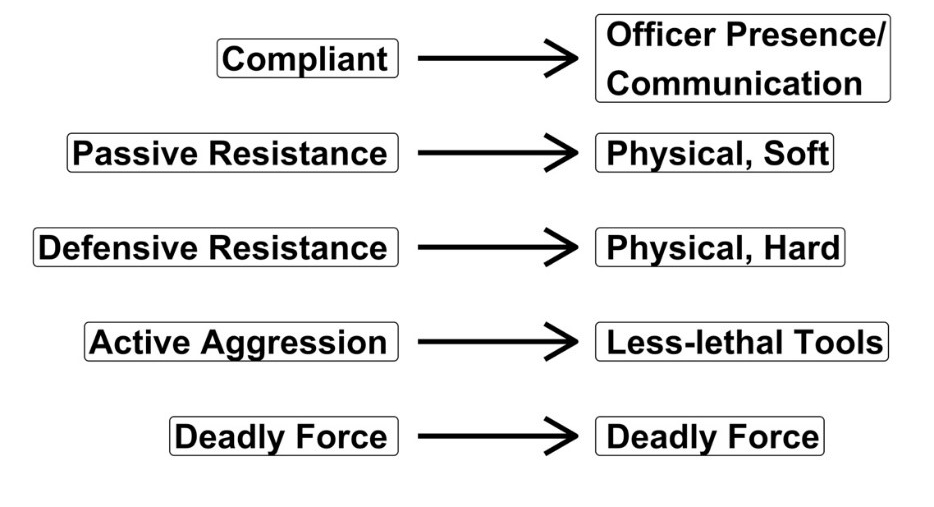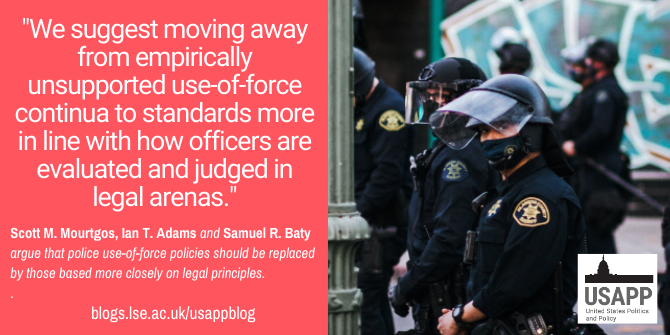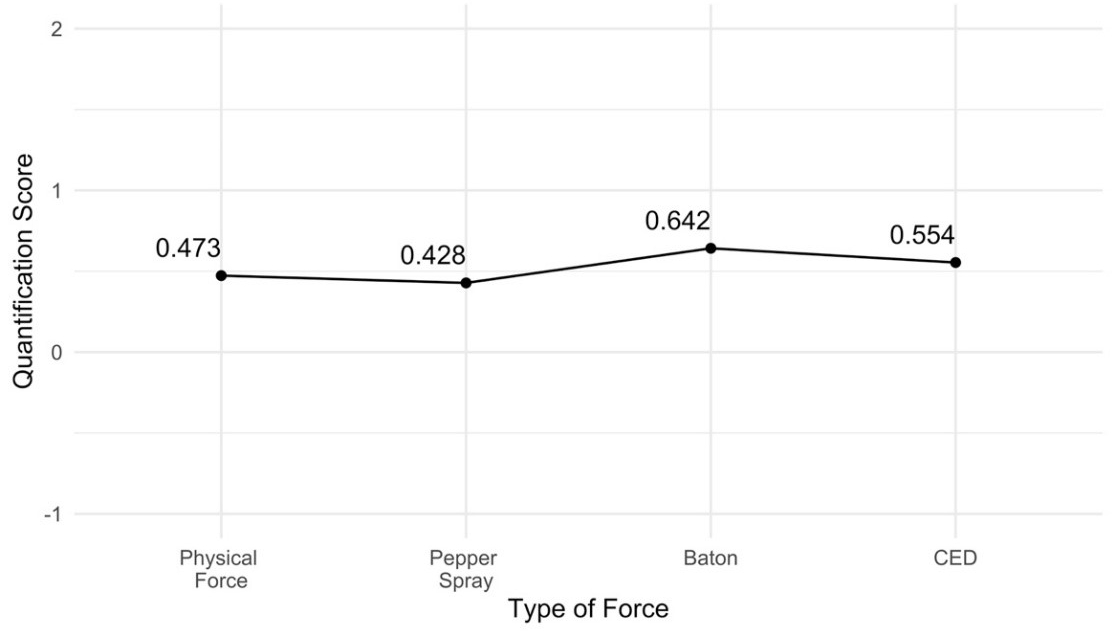

 In the United States, many police forces determine how much force to use when dealing with suspects through a continuum which ranks different levels of force based on resistance. In new research which examines more than 700 use of force incidents in one city, Scott M. Mourtgos, Ian T. Adams and Samuel R. Baty find that there is very little difference in how police use less-lethal force, despite this apparent ranking. They argue that rather than using continuums to determine the level of force to use, US police forces should base their use of force on legal principles.
In the United States, many police forces determine how much force to use when dealing with suspects through a continuum which ranks different levels of force based on resistance. In new research which examines more than 700 use of force incidents in one city, Scott M. Mourtgos, Ian T. Adams and Samuel R. Baty find that there is very little difference in how police use less-lethal force, despite this apparent ranking. They argue that rather than using continuums to determine the level of force to use, US police forces should base their use of force on legal principles.
Even before the murder of George Floyd in Minneapolis, Minnesota, by a police officer at the end of May 2020, how and why police use force in their professional duties has been a highly charged and important public concern. There are two primary accountability mechanisms employed to deter excessive police use-of-force in the United States: legal standards and individual agency use-of-force policies. While police agencies’ use-of-force policies invariably incorporate legal standards, agency policies are often more specific and detailed.
In new research, we argue the conceptual structure that the current use-of-force policies which put levels of force on a continuum are built upon does not withstand empirical scrutiny. These current use-of-force policies are an administrative attempt to guide officers regarding which type of force they are authorized to use. However, our analysis suggests this administrative control should be replaced with guidance based on legal principles. An example of this type of legal control can be found in the National Consensus Policy for police use-of-force adopted by the International Association of Chiefs of Police.
Contemporary Use-of-Force Policies
Contemporary use-of-force policies rely upon force continua, where a given level of force is authorized at a given level of subject resistance. Figure 1 below is a force continuum found in many use-of-force policies across the United States. So, for example, if a subject were exhibiting passive resistance, an officer would be authorized to use physical, soft force techniques on that subject (e.g., pushing, grabbing). If a person were exhibiting active aggression, an officer would be authorized to use less-lethal tools (e.g., Taser, baton, pepper spray).
Figure 1 – Force Continuum

The above force continuum (and other permutations used by agencies across the country) is presented as a scale which explicitly ranks the use of certain force techniques. With an explicit assumption of this ranking within police use-of-force policies, one might assume that there is widespread agreement across the country regarding the rankings of resistance and force. However, this is not the case. There is astonishingly little consensus upon the rankings of these categories from one police agency to the next.
Poor conceptualization of the various elements of force leads to unending questions for officers, administrators, legal scholars, the public, and researchers alike. Is striking someone in the head with a closed fist less or more severe than hitting them in the leg or arm with a baton? Is applying pepper spray to a subject more or less severe than using a Taser? Or, if the rankings for different forces are unsupported, are these options false choices that represent effectively equal force in terms of severity?
How do police actually use force?
In the conventional frame of ranking forces, there are no clear answers to the above questions. Ranked variables require an explicit ordering of the available categories. With more than 100 different permutations of force progression found across the United States, this assumption should be questioned. In recent research, we test the ranking assumption and investigate how less-lethal force categories are ranked.

Photo by Gabe Pierce on Unsplash
We constructed a unique dataset of every use-of-force incident – over 700 instances – involving non-lethal force in 2018 at a large metropolitan police agency. The agency uses one of the most common continuums in the United States (see Figure 1 above). First, as expected, we found that subjects’ resistance levels account for a substantial portion of the variance in the type of force used by officers. Second, as Figure 2 shows, when quantifying the distance between different levels of less-lethal force in terms of subjects’ resistance, we found that pepper spray scores below the use of physical force (e.g., pushing, punching, kicking). Further, dimensionally, very little separates the use of physical force, the use of a baton, and the use of Tasers. These findings are contrary to the assumptions built into the force continuum used by the agency we studied.
Figure 2 – Quantification scores by force type

Perceptions about force strength do not reflect how they are ranked
Despite the widespread use of these continua by law enforcement agencies, there is little research on whether the implicit assumptions of the ranking that is built into these tools matches the underlying empirical reality. Our analysis suggests that the assumptions about the rankings of force are not met. Instead, force continua are ordered categories that do not contain information about the distance between levels of force. In other words, while use-of-force continua convey substantive differences between different ‘levels’ of less-lethal force, our findings question whether these levels truly exist.
Our analysis complicates the assumptions of progression of less-lethal force found in many police agencies’ use-of-force continua. Our findings mirror recent evidence that lay people also do not easily distinguish between varying forms of less-lethal force. These findings raise the question: How have police agencies determined where different types of force should be located within their force continua? Are these decisions based on the personal preferences of agency administrators? Are these decisions based on lawsuits and other liability exposure? Do newer less-lethal tools get placed higher on the continuum as they are introduced to the policing industry because they are new and therefore perceived as a more “serious” force option (i.e., Tasers)? Our review of the history of introducing pepper spray and Tasers to the field of policing suggests this latter possibility deserves more attention.
Moving to a use of force policy based on legal principles
Unfortunately, our findings cannot answer these and similar questions. Is striking someone in the head with a closed fist less or more severe than hitting them in the leg or arm with a baton? Is applying pepper spray to a subject more or less severe than using a Taser? Our results seem to indicate that there is very little difference between types of less-lethal force. This is one of the reasons why the National Consensus Policy for police use-of-force strongly discourages use-of-force continua in use-of-force policies. Instead, the consensus policy suggests that police organisations should allow officers to select a level of force based on the legal principles they are ultimately judged by in a court of law. That is, was the force used by an officer “objectively reasonable” based on the totality of the circumstances, what the officer knew at the time, and what a reasonably prudent officer would use under similar circumstances.
We suggest moving away from empirically unsupported use-of-force continua to standards more in line with how officers are evaluated and judged in legal arenas. As discussed in the National Consensus for police use-of-force, this allows officers to better enforce the law, protect the public, guard their safety and that of innocent bystanders, and provide for a workable and legally sound accountability measure.
- This article is based on the paper, ‘Challenging the Ordinality of Police Use-of-Force Policy’, in Criminal Justice Policy Review.
Please read our comments policy before commenting
Note: This article gives the views of the authors, and not the position of USAPP– American Politics and Policy, nor of the London School of Economics.
Shortened URL for this post: https://bit.ly/2Z1VtWm
About the authors
 Scott M. Mourtgos – University of Utah
Scott M. Mourtgos – University of Utah
Scott M. Mourtgos is a Ph.D. candidate in political science at the University of Utah and a National Institute of Justice LEADS Scholar. His research interests include policing, advanced computational methods in social science, and criminal justice policy. His recent work has appeared in Justice Quarterly, Journal of Criminal Justice, and Criminology & Public Policy. His research can be found at https://smourtgos.netlify.app/.
 Ian T. Adams – University of Utah
Ian T. Adams – University of Utah
Ian T. Adams is a Ph.D. candidate in Political Science at the University of Utah where he also completed a Masters of Public Administration. His multi-disciplinary research interests include body-worn cameras and policing workplace surveillance, and advanaced computational methods in social science. His recent work has appeared in Public Administration Review, Criminology & Public Policy, and Justice Quarterly. His research can be found at https://ianadamsresearch.com/.
 Samuel R. Baty – University of Utah
Samuel R. Baty – University of Utah
Samuel R. Baty is a fourth-year Ph.D. candidate in the political science department at The University of Utah where he studies public administration and international relations. Sam also currently works as a graduate researcher at Los Alamos National Laboratory. Prior to coming to Utah, Sam received his B.S. with academic honors in mathematics and economics from the University of California, Los Angeles.






